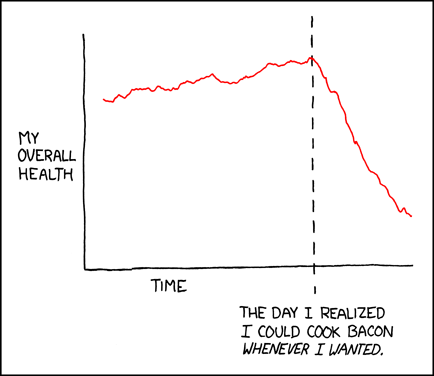
(This is my first post here, and I thank Arbet for granting me the honor although, technically, I’m not a bachelor anymore. 😉 Comic credit: Stove Ownership by XKCD)
When a bachelor decides to cook “for real” (that is, use a stove and pots and pans instead of a microwave oven) he has to go through this unimaginably excruciating process of deciding what stuff to get.
Of course, of prime consideration is budget. It might occur to him to scrimp on cooking stuff because he’d probably use the stuff only half the time (eating out and, well, microwaving stuff on the other half). But he only needs to remind himself that a.) he’s playing with fire and b.) he’s dealing with stuff he puts in his mouth to realize that being cheap with kitchen stuff isn’t worth the risk.
Of course I learned part of this lesson the hard way.
The only stuff I didn’t scrimp on was the stove. While I didn’t get an expensive La Germania, I took a Nikon dual-burner for 750 pesos and a 400+ peso gas regulator. Fire is something I really didn’t even want to entertain — but I didn’t want to get an electric stove either (curse you Meralco!). I also got a model with automatic ignition — didn’t want to bother with lighters, lighter fluid, and matches anyway.
The pots and pans were a different story. I found these cheap China-made pans in SM Hypermarket that sold for 275 pesos. That’s for 20″, 24″, and 28″ frying pans. I also got a stainless steel pot, a nylon turner/spatula (the one you use for frying), a steel can opener and a steel ladle. I got the cheapest ones I could find. I’m all set.
First sign of trouble came with the can opener. It just wasn’t… sharp enough. It cut through the can on the first “bite” came through fine, but when you turned the handle it just went up the can cover and made a shallow dent.
Crap. I borrowed a can opener from a neighbor just to be able to eat breakfast.
A few weeks later and it was evident just how cheap the pans and the turner were. Plastic flakes was coming off of the turner’s edge, and the non-stick coating on the small and medium pans were mottling after just a few days use. The worst story was the large 28″ pan. The moment I picked it up filled with food, the pan handle just gave. And that was the first time that pan was used.
Crap! Good thing the food did not spill.
When the non-stick material on the cheap pans just whittled away after a few weeks, I finally gave them up and decided to get real pans. Good thing some branded, Teflon coated pans were on sale in SM. Got thicker pans with real Teflon on them for half the price. Great. All of the cheap China pans were retired.
But there’s no such thing as a coincidence, and one of the Teflon pans revealed its reason to come into my kitchen a few weeks later.
I woke up a little earlier than usual, and decided to have the longganisa that I requested that had come from Pangasinan. I got a Teflon pan, put water in it, brought the water to a boil, put in the longganisa. Then, for some reason, I put down the nylon turner ON the pan’s edge, and sat down, waiting.
And fell asleep.
Shit happens when you mix cooking and sleep, of course.
I woke up with the loud sizzling on the pan and the stench of burning plastic. SHIT. I stood up and hurried to the stove to find the nylon turner melted three fourths of its way through the pan’s edge. SHIT! I turned the fire off, picked pan and turner, hurried to the sink and turned on the water.
It was too late. Sticky, molten plastic had trickled down both the inner and outer surface of the pan, with small particles dribbling within the oil that was supposed to cook my breakfast/baon. The turner was beyond repair, and I had lost 8 pieces of absolutely delicious but carcinogen-coated longganisa. Worse, a thick blob of plastic stuck itself on a 500 peso frying pan!
Frustrated, I threw the turner and longganisa in the trash, and poured dishwashing liquid on the pan. Hoping against hope, I scrubbed on the cooking surface of the pan — and just like that, the blob of hardened plastic detached itself from the cooking surface. I was surprised, but then it occurred to me: Teflon was supposed to do this, that is, keep stuff from sticking to it permanently. And that’s why it’s that expensive.
Unfortunately the plastic that dried on the outer surface of the pan won’t come off as easily. It continues to cling to the pan as a reminder of that whole disaster.
I now use a stainless steel turner, making sure I do not scrape the Teflon surface too hard.
